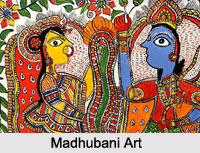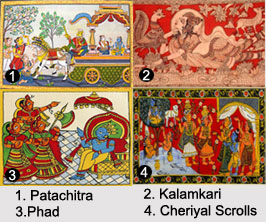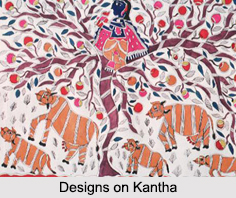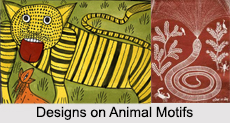Introduction
 Folk Arts of India are quite well developed. They are different from primitive art forms in which they are more finished, polished, complex and stylised. Folk art came after the village settlements were established. It is marginally developed and more finished in nature. The common people are the mainspring of folk art.
Folk Arts of India are quite well developed. They are different from primitive art forms in which they are more finished, polished, complex and stylised. Folk art came after the village settlements were established. It is marginally developed and more finished in nature. The common people are the mainspring of folk art.
Folk art forms may accompany the celebration of various religious, social and family festivals. The problem of fertility both in case of human beings and land, the problem of natural disasters like floods, famines and fire, diseases and accidents, directly or indirectly, provide the theme for folk art. The main purpose of folk arts is three-fold; which satisfy people`s passion for religious rituals, entertainment as well as social interaction.
Features of Folk Arts in India
Folk arts, as distinct from tribal art and traditional art, exhibit certain characteristics which are typical to this art form alone. The compositions either do not claim any author or are adopted from written texts. But neither the performers nor the audience are interested in the source of the text or the author. Folk art is mostly orally transmitted and passes from generation to generation through Guru-Sishya Parampara. The folk arts have no watertight compartmentalisation among themselves and there is seen a mixture of dance, song, music and drama.
The division into dance, drama and musical forms made basing on emphasis. The music used in the folk arts is mostly Bhava-centric music. The stress is on Tala (rhythm) and though all kinds of instruments are used, the most important instruments used are percussion instruments. Most common kinds of Anabadha (drum) Vadyas are Dhol, Mardal, Khol, Pakhavaj etc. The Ghana (brass) instruments are Gird, Jhanja, Kartal etc. A particular feature of folk art is the presence of body language and histrionics even where no actual dramatic plot exists.
Types of Folk Arts in India
Earliest Indian folk painting and art styles have been passed down from invention to generation and are still practised in diverse parts of the country. Following are the main types of folk arts of India:
Miniature Paintings: Initiated in the Mughal period, about 16th century, Miniature paintings are inclined by Persian styles and prospered under Shah Jahan and Akbar`s regulation. These paintings are symbolized by its miniature size but elaborate details and delicate expressions.
Madhubani: It is one of the most popular Indian folk arts, practiced mostly by women who wanted to be one with God. It is also called Mithila art; it initiated in the kingdom of Janak in Nepal and in there-day Bihar.
 Patachitra: It was originated from the 5th century in religious hubs like Puri and Konark. It is a cloth-based scroll painting from Odisha and West Bengal.
Patachitra: It was originated from the 5th century in religious hubs like Puri and Konark. It is a cloth-based scroll painting from Odisha and West Bengal.
Warli: This is simply one of the oldest art forms of India. It was initiated by the Warli tribes from the Western Ghat of India. All the paintings are done on a red yellowish-brown or dark background, while the shapes are white in colour.
Phad: Phad is mainly a religious form of scroll painting depicting folk deities Pabuji or Devnarayan. The 30- or 15 feet-long canvas or cloth that it is painted on is called phad. It was originated in Rajasthan.
Gond: The colours come from charcoal, cow dung, leaves and coloured soil. The Gondi tribe in Madhya Pradesh produced these bold, brightly coloured paintings, depicting mostly flora and fauna.
Kalamkari: There are two types of Kalamkari in India; Machilipatnam which initiates from Machilipatnam in Andhra Pradesh and Srikalahasti. Kalamkari art is used on sarees and cultural clothing and portrays everything from flora and fauna to epics such as Mahabharata or Ramayana.
Tanjore: Tanjore or Thanjavur paintings initiated in 1600 AD. These pane paintings on wooden planks portray devotion to gods, goddesses and saints.
Cheriyal Scrolls: This vanishing art form is followed by the Nakashi family only. These 40-45 feet scrolls were a necessary visual complement as saints wandered around singing or narrating the epics which depicts puranas and epics.
Kalighat Paintings: It originated in the 19th century Bengal, from Kalighat. These paintings, on cloth and pattas portrayed Gods and Goddesses but then took a turn headed for social improvement.
Batik: Batik arts also constitute a significant form of folk arts in the nation. Artists like Ganga Devi have contributed largely to the different types of folk arts in India.
Other interesting folk arts found here are the Rajasthani paintings, Tanjore paintings, Kalamajhethu and Alpana floor creations, Tibetan Scrolls, `Bandhani` print work, glass painting and numerable others.
 Symbols and motifs are used to design all kinds of folk arts of West Bengal. They are the manifestations of the culture, tradition and daily life of the tribal people who dedicate themselves in making those crafts. There are several kinds of symbols and motifs of folk art; for example birds, fish, leafy designs, men and women and many other common decorative patterns are seen on the folk arts of West Bengal with deep significance on them.
Symbols and motifs are used to design all kinds of folk arts of West Bengal. They are the manifestations of the culture, tradition and daily life of the tribal people who dedicate themselves in making those crafts. There are several kinds of symbols and motifs of folk art; for example birds, fish, leafy designs, men and women and many other common decorative patterns are seen on the folk arts of West Bengal with deep significance on them.
Purposes of Symbols and Motifs of Folk Art : The purposes of using symbols and motifs on folk art are uncountable. From painting "alpona" during religious rituals to "kantha" stitching with designs, designing wooden moulds to prepare "chandrapuli" and "amsatta", decorating plaited mats, weaving hand fans with multicolored threads, painting wooden seats, trays, carved wood and wooden dolls, symbols and motifs are used everywhere to express the feelings of the artisans.
Types of Symbols and Motifs of Folk Art : The most common symbols and motifs, used to design the folk arts, are lotus buds, "kalmi" or watercress creepers, paddy stalks, "shankha-lata" or design of creepers composed of conch shell diagrams, wavy and interwoven leaves and creepers, "khunti-lata" or composition of cooking spuds and other domestic articles, footprints, peacocks and other birds, betel leaves, fish, date leaves, diaper designs, rhombus-shaped designs etc. These motifs were originated from leaves, creepers, flowers, rivers, birds and animals, fish, pets, sun, moon, stars, planets and several objects of daily life:
 Designs on "Alpona": Among the designs on "alpona", the most recreational motif is the portrayal of "a woman holding a child by hand and a child in her arm"; this motif depicts the motherhood. This motif can also be found in the terracotta Shashthi dolls made in Panchmurho, Bankura and the rounded dolls of 10th or 12th century BC, which were discovered during the archeological expeditions at Tamluk in Medinipur and Harinarayanpur in South 24 Parganas districts.
Designs on "Alpona": Among the designs on "alpona", the most recreational motif is the portrayal of "a woman holding a child by hand and a child in her arm"; this motif depicts the motherhood. This motif can also be found in the terracotta Shashthi dolls made in Panchmurho, Bankura and the rounded dolls of 10th or 12th century BC, which were discovered during the archeological expeditions at Tamluk in Medinipur and Harinarayanpur in South 24 Parganas districts.
Snake Motif: Another motif, especially created for women, has gained immense popularity which depicts a snake held in the beak of a peacock. This motif is mostly found in the wooden moulds made by women for making "chandrapuli" and "amsatta", "kantha" designs and wooden boxes etc. This snake motif can also be seen in the terracotta sculptures on the temples of medieval period and on the decorative panels of wooden doors. Reproductions of this motif are also seen in the Rajasthani miniatures and wall paintings. During an excavation in Bardhaman, a remarkable exhibit of this popular motif has been discovered on a broken vessel of clay, which dates back to almost 1500 BC of Pandu kingdom.
Footprint Motif: "Footprint" motif on "alpona" paintings is also one of the common and yet popular motif of folk art. It is drawn on the floors during the worship of Goddess Lakshmi and many other ancient sculptures of Hindu, Buddhist and Jain. For example, the architectural edifice of Kadamrasul of the erstwhile Gourh kingdom in Maldaha District was built to worship a pair of footprints, which was engraved on stone. Date leaves are a common motif used to design "kanthas"; it is known as "khejurey chhorrhi" engravings - khejur means date and chhorrhi means a stick.
Creeper of Conch Shell Motif: The depiction of a creeper of conch shells is woven on the "baluchari" sarees. This motif is also often been found on the paintings of the Ajanta caves, which looks similar to the shape of a mango. Apart from that, diaper motif is also found on the designs of saris along with bangles of conch shells, hand fans, plaited mats etc. The diaper motif, being geometrical design, was originated from flowers and leaves.
Leafy and Flower Motifs: Terracotta engravings on the walls of temples and mosques are called "patralata" or leaf and creeper design. They are also seen on the entrance gates of the temples. Lotus petal designs were also engraved in the stone sculptures of many ancient temples; they are called "phulballi" or flower and creeper designs. This motif was influenced from the "panchamark" coins, cast copper coins and earthen vessels of the Maurya-Sunga period.



















